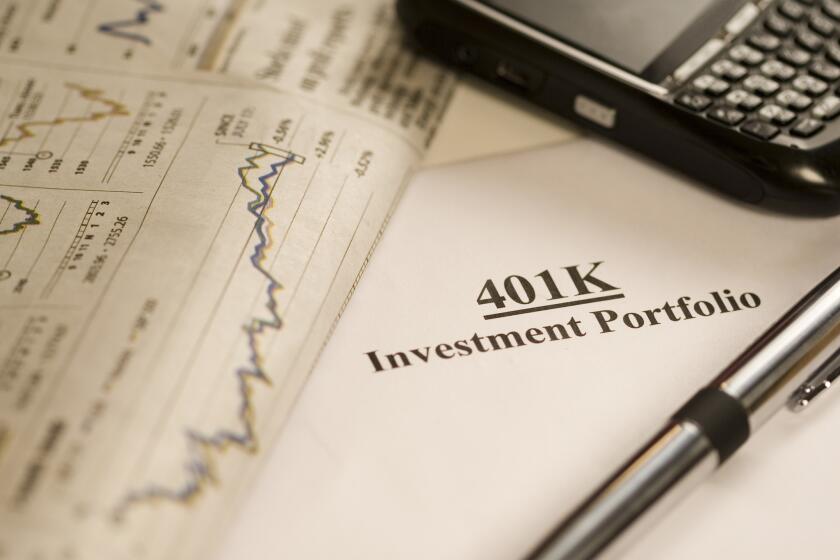Column: ‘Buy when blood is in the streets,’ and other maxims from bear markets past
The story is told that one day a friend told J. Pierpont Morgan that he was so worried about his stocks that he couldn’t sleep at night. What should he do?
“Sell down to the sleeping point,” Morgan is said to have replied.
The anecdote dates to the 1890s, and its attribution to the man who then dominated American finance with such authority that he was nicknamed “Jupiter” may be apocryphal. But it raises two points.
One is that it encompasses a truism, which is that investors should divorce their emotional response to the markets from the cold analysis that should underlie investment decisions, if they can. The other is that stock market history is brimming with lessons from downturns of yore, often digested into bite-sized maxims.
It’s important to keep in mind that while some of these maxims pack lots of wisdom into small bites, some have turned out to be wrong. Financiers, no matter their prominence or authority in their own times, aren’t exempt from allowing their personal hopes and aspirations to cloud their judgment. And sometimes Mr. Market can just throw a curve.
With borrowing rates this low, the U.S. government should borrow and build to combat the novel coronavirus.
It will be noticed that a lot of the wisdom chronicled here is contradictory; sometimes, when it comes to the investment markets, you don’t know nothin’. That may be why economist Burton Malkiel’s book “A Random Walk Down Wall Street,” which counseled a buy-and-hold strategy using index funds and was first published in 1973, is now in its 12th edition.
Also, we’re not offering investment advice here. Whether you’re holding onto your portfolio, bailing out or pondering whether to jump in, you’re on your own. We are merely pointing out that whatever you do, history is looking over your shoulder — or to put it another way, an angel is on one shoulder and a devil on the other.
That said, let’s take a look at what sages of the past have counseled.
We’ll begin with what may be the maxim with the most apocalyptic flavor, perhaps appropriate for this moment of pandemic panic.
1. “The time to buy is when there’s blood in the streets.” Generally attributed to Baron Nathan Mayer Rothschild, who was active around the turn of the 19th century, this is the quintessential contrarian mantra. The idea is that by pushing asset values down, generalized gloom and panic produce sterling buying opportunities.
This may be the advice that has best stood the test of time. Mob sentiment is often wrong, or in any event overestimates reality. The idea works in both directions: When everyone thinks the world is going to hell, it’s time to buy, and when everyone thinks the outlook couldn’t be rosier, it’s time to sell. It should not have escaped close observers of the market that stock indexes had reached historic highs in January, just before things became unstuck.
A payroll tax cut was a bad idea in President Obama’s time, and even worse now.
The problem, of course, is that one cannot always tell when sentiment has peaked in either direction. Just because things look dark, that doesn’t mean they can’t get darker. By the same token, enthusiasm can beget more enthusiasm for a long time. Former Federal Reserve Chairman Alan Greenspan warned in 1996 that the stock market had been gripped by “irrational exuberance.” The market continued rising for the next four years.
2. “Stocks will fluctuate.” Variously attributed to Morgan, John D. Rockefeller, Jay Gould and others, this is treated as an observation that is undeniably true and virtually useless. It tells investors nothing about what the market will do in the near term, or at least within the time frame in which investors generally try to make decisions. It does, however, counsel that anyone getting into the investment markets should not expect a steady, carefree ride.
3. “Buy low, sell high.” All-purpose investing advice, a family relation to maxim No. 2. No one who follows this advice will lose money investing, but no one can conceivably follow it without error. How does one know when stocks are “high,” or when they’re “low”?
That’s why Malkiel’s advice to stick to index funds has tended to work. He and many others caution lay investors to avoid trying to “time the market” — that is trying to pick the moments to sell or buy. They counsel investors with money to invest to practice dollar cost averaging, which means investing a set sum in the market on a set schedule, and not deviating. The virtue of dollar cost averaging is that one buys more shares when they’re cheaper, and fewer when they’re more expensive.
Dollar cost averaging takes emotion and guesswork out of investing, which could be an even more useful virtue. Consider the strategy that became popular during the recent bull market of “buying the dips” — that is, hold your fire until the market experienced a (presumably temporary) downturn.
Trump’s economy has been great for stock investors, but not for workers.
As Nick Maggiulli of Ritholtz Wealth Management observed last month, buying the dip underperformed dollar cost averaging even when the buyer has God-like knowledge.
“Buying the dip only works when you know that a severe decline is coming and you can time it perfectly,” he wrote. That’s because the strategy requires keeping money out of the market except when major dips occur, which is rarely. The cost of staying on the sidelines is significant. “Missing the bottom by just 2 months lowers the chance of outperforming DCA from 30% to 3%,” Maggiulli calculated.
4. “October. This is one of the peculiarly dangerous months to speculate in stocks. The others are July, January, September, April, November, May, March, June, December, August and February.”
The source of this observation can at least be documented. It’s from Mark Twain’s book “Pudd’nhead Wilson,” which is shot through with such aphorisms.
Twain was pointing cynically to the prospect that the small investor is always the one who gets sheared by market insiders. (This may not be entirely wrong, in his time or now.) The crack has given Twain the aura of a sage, because the “October effect” he appeared to be pinpointing has proved true, since the crashes of 1929, 1987 and 2008 all peaked in that month. But that’s certainly coincidental — “Pudd’nhead Wilson” was published in 1894.
A leading conservative and leading liberal agree that 401(k) plans aren’t doing enough to help Americans save for retirement.
Twain may actually have been alluding more to the depredations of the period of ostentatious greed, investment euphoria and speculation to which he gave the name the Gilded Age, through the book of that title he co-wrote with Charles Dudley Warner and published in 1873.
5. “Stocks have reached what looks like a permanently high plateau.”
Pity poor Irving Fisher. Perhaps the most famous economist of his time, the Yale professor is still revered among economics professionals for his brilliant contributions to economic theory. To the public at large, however, his reputation rests on this fatuous statement, made on Oct. 16, 1929, the week before the Great Crash.
Undaunted by being proved spectacularly wrong about the stock market, Fisher followed up this observation with another, published in a 1930 book, that “for the immediate future, at least, the outlook is bright.” The Great Depression was already knocking at the door.
There isn’t much more to be said about either of these pronouncements, other than analyzing the stock market is hellishly difficult in real time, and that even great economists can have their own sets of blinders.
6. “Whether concerning an individual stock, or the market as a whole, always ask yourself which would be more of a surprise: good news or bad news. News that is expected never has as much impact — if any at all — as news that is not.”
Andrew Tobias’ book “The Only Investment Guide You’ll Ever Need” may be one of the few self-help books that lives up to its brash title. First published in 1974, in the same period as Malkiel’s book, it’s remained in print ever since. Tobias warned his readers away from elaborate strategies and complicated investments such as commodities, and was appropriately skeptical about brokerage advice and other come-ons that can appear to be free and unbiased but often are not.
The hallmark of Tobias’ book is its understanding of investor psychology. “Torn as we all are between greed and fear,” he writes, “we tend to do just the wrong thing. When the economy is sinking fast and stocks faster, we get more and more scared. Finally, we quit in disgust. Better to get out with the big loss, we say to ourselves, than to watch our holdings disappear altogether. In fact, of course, this is just the time to be getting into the market, not out.”
More to Read
Inside the business of entertainment
The Wide Shot brings you news, analysis and insights on everything from streaming wars to production — and what it all means for the future.
You may occasionally receive promotional content from the Los Angeles Times.















